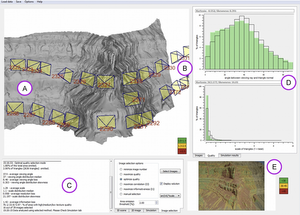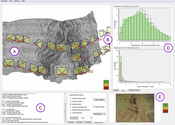Information
- Publication Type: Journal Paper (without talk)
- Workgroup(s)/Project(s):
- Date: March 2013
- Journal: Computers & Geosciences
- Volume: 52
- Pages: 281 – 291
Abstract
Photorealistic 3D models are used for visualization, interpretation and spatial measurement in many disciplines, such as cultural heritage, archaeology and geoscience. Using modern image- and laser-based 3D modelling techniques, it is normal to acquire more data than is finally used for 3D model texturing, as images may be acquired from multiple positions, with large overlap, or with different cameras and lenses. Such redundant image sets require sorting to restrict the number of images, increasing the processing efficiency and realism of models. However, selection of image subsets optimized for texturing purposes is an example of complex spatial analysis. Manual selection may be challenging and time-consuming, especially for models of rugose topography, where the user must account for occlusions and ensure coverage of all relevant model triangles. To address this, this paper presents a framework for computer-aided image geometry analysis and subset selection for optimizing texture quality in photorealistic models. The framework was created to offer algorithms for candidate image subset selection, whilst supporting refinement of subsets in an intuitive and visual manner. Automatic image sorting was implemented using algorithms originating in computer science and information theory, and variants of these were compared using multiple 3D models and covering image sets, collected for geological applications. The image subsets provided by the automatic procedures were compared to manually selected sets and their suitability for 3D model texturing was assessed. Results indicate that the automatic sorting algorithms are a promising alternative to manual methods. An algorithm based on a greedy solution to the weighted set-cover problem provided image sets closest to the quality and size of the manually selected sets. The improved automation and more reliable quality indicators make the photorealistic model creation workflow more accessible for application experts, increasing the user’s confidence in the final textured model completeness.Additional Files and Images
Weblinks
BibTeX
@article{Viola_Ivan_2013_CAI,
title = "Computer-aided image geometry analysis and subset selection
for optimizing texture quality in photorealistic models",
author = "Aleksandra Anna Sima and Xavier Bonaventura and Miquel
Feixas and Mateu Sbert and John Anthony Howell and Ivan
Viola and Simon John Buckley",
year = "2013",
abstract = "Photorealistic 3D models are used for visualization,
interpretation and spatial measurement in many disciplines,
such as cultural heritage, archaeology and geoscience. Using
modern image- and laser-based 3D modelling techniques, it is
normal to acquire more data than is finally used for 3D
model texturing, as images may be acquired from multiple
positions, with large overlap, or with different cameras and
lenses. Such redundant image sets require sorting to
restrict the number of images, increasing the processing
efficiency and realism of models. However, selection of
image subsets optimized for texturing purposes is an example
of complex spatial analysis. Manual selection may be
challenging and time-consuming, especially for models of
rugose topography, where the user must account for
occlusions and ensure coverage of all relevant model
triangles. To address this, this paper presents a framework
for computer-aided image geometry analysis and subset
selection for optimizing texture quality in photorealistic
models. The framework was created to offer algorithms for
candidate image subset selection, whilst supporting
refinement of subsets in an intuitive and visual manner.
Automatic image sorting was implemented using algorithms
originating in computer science and information theory, and
variants of these were compared using multiple 3D models and
covering image sets, collected for geological applications.
The image subsets provided by the automatic procedures were
compared to manually selected sets and their suitability for
3D model texturing was assessed. Results indicate that the
automatic sorting algorithms are a promising alternative to
manual methods. An algorithm based on a greedy solution to
the weighted set-cover problem provided image sets closest
to the quality and size of the manually selected sets. The
improved automation and more reliable quality indicators
make the photorealistic model creation workflow more
accessible for application experts, increasing the user’s
confidence in the final textured model completeness.",
month = mar,
journal = "Computers & Geosciences",
volume = "52",
pages = "281--291",
URL = "https://www.cg.tuwien.ac.at/research/publications/2013/Viola_Ivan_2013_CAI/",
}


